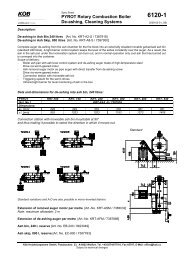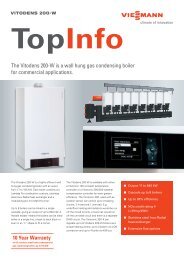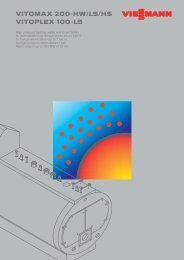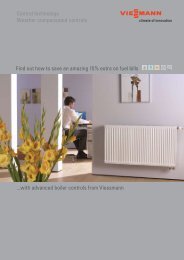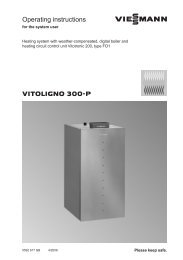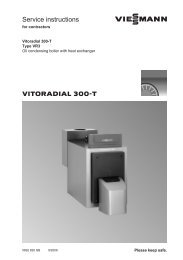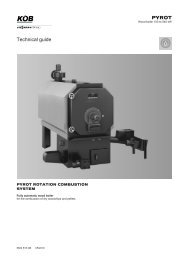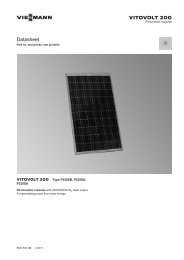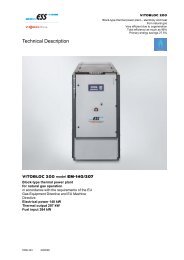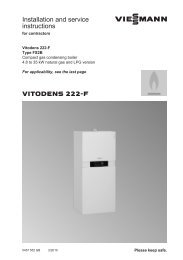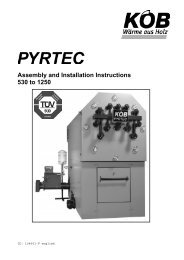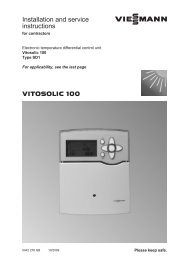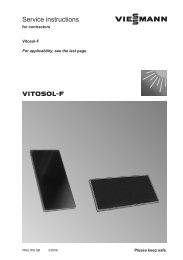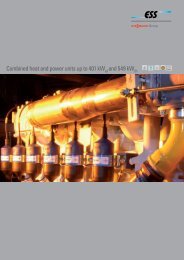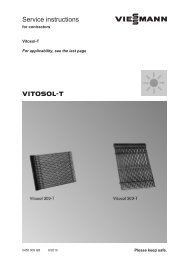Weather Compensation brochure413 KB - Viessmann
Weather Compensation brochure413 KB - Viessmann
Weather Compensation brochure413 KB - Viessmann
Create successful ePaper yourself
Turn your PDF publications into a flip-book with our unique Google optimized e-Paper software.
<strong>Weather</strong> compensationFind out how to save an amazing 20% extra on fuel bills... with advanced boiler controls from <strong>Viessmann</strong>
Save for the Future with <strong>Viessmann</strong>With ever increasing fuel bills andthe need to be as eco-friendly aspossible, it’s important that we alllook for ways to save fuel and carbonemissions – and money!All boilers now have to becondensing boilers and thisrepresents a huge step forward inenvironmentally friendly heating,withfuel savings of up to 35% comparedto conventional boilers.But there is a way to save evenmore – up to 20% in fact, with justa simple outdoor sensor and somevery clever <strong>Weather</strong> <strong>Compensation</strong>controls, available with the Vitodensrange of condensing boilers.For a relatively small investmentyou’ll not only save up to 20% morefuel each year but you’ll also enjoyan incredibly comfortable home –with a pleasant indoor temperature– whatever the weather.Heating - The BasicsOur homes need heating, to replaceheat lost through the walls etc. Thecolder it is outside, the more heat islost and the more we have to heatthe building, to replace that heat,especially in the winter, when theheat loss is at its highest level.This basic explanation isfundamental to understanding howan outdoor weather sensor can helpto heat your home in a more efficientand cost-effective way.<strong>Weather</strong> compensation controlswork by ensuring that the boilerburns the exact amount of fuelrequired to match the heat lostfrom the building. The house willalways be warm (at the desiredtemperature) and will never be toohot or too cold.Conventional ControlsTraditional heating systems have a room thermostat indoors and this is the sequence that follows a fall in temperature.1. Outsidetemperaturedrops2. More heat is lostthrough the walls& windows3. Rooms get colder -which is detected bythe room thermostat4. Thermostat 'tells'the boiler to fire/work harder5. Rooms getwarmer againIn the above example, it isn’t until stage 4 that the boiler gets any ‘feedback’ and is able to respond to changing conditions.The chances are that at this stage, the householder will be feeling the cold and will turn the thermostat up even further -wasting even more fuel.If the outside temperature rises, the boiler will not respond until the rooms have become uncomfortably warm - so in addition toadjusting thethermostat, there’ll probably be the temptation to open some windows, releasing more heat and wasting more energy.With a weather compensation system, the boiler is able to respond at stage 1 - see opposite.
<strong>Weather</strong> <strong>Compensation</strong> ControlsWith weather compensation the sequence of events changes considerably:1. Outside temperaturedrops - which is detectedby outdoor sensor2. Boiler operates at ahigher temperature3. Radiators get warmerto compensate forheat lost*4. Room temperatureis maintained* The small, constant adjustments mean that the radiators should feel warm, rather than hot, then cold.In this example, as soon as the outside temperature falls, the boiler is able to respond instantly because the sensor iscontinually sending information to the boiler.If the outside temperature rises, the boiler will automatically run the radiators at a lower temperature, to maintain the correctlevel. The householder will be unaware of these small constant adjustments and does not have to touch any controls orthermostats to enjoy a constant, comfortable temperature.What does it mean to the householder?Lower fuel bills - save up to 20% of your annual fuel bill – that’s on top of the savings you’ll make by changing a conventionalboiler for a condensing boiler.A comfortable home - a constant temperature is maintained inside, despite what the weather’s doing outside.You won’t even notice the changes - because the system is pro-active, rather than reactive, you won’t notice the subtletemperature changes. You certainly won’t be feeling the cold and don’t need to worry about adjusting a room thermostat.An even quieter boiler - if you’ve already got a <strong>Viessmann</strong> boiler, you’ll know that they operate incredibly quietly. With weathercompensation the boiler should fire so infrequently that for the first few months you’ll probably keep checking it’s still on!Cooler radiators - a good sign that the weather compensation is working well, is that the radiators will feel warm, but won’t getvery hot, then cool. This is because the small adjustments mean that a steady temperature is maintained, with few fluctuations.Piping hot water - even though the radiator temperature is kept low, you have the reassurance that, at the same time, thetemperature of water in the cylinder is maintained, for piping hot water when required.Lots of additional control features and functions – see back page.the power to choose
Boiler flow temperature ºC80º75º65º55º0ºWith weather compensationWithoutweather compensationTimeHow does it work?A small temperature sensor islocated on the outside of thebuilding, on a north facing wall. Thisis wired to the internal controls ofthe boiler and information about theoutside temperature is sent to theboiler every few seconds.When the temperature changesoutside the boiler responds andstarts to increase or decrease theradiator temperature to compensate.This pro-active mechanism meansthat people inside the building won’teven notice that the temperature haschanged outside.For example, when the outsidetemperature drops at night, moreheat is lost through the walls ofthe building. Because the outdoorsensor detects the fall as soon as ithappens, the boiler is able to startworking a little harder to increasethe radiator temperature and keepthe inside temperature stable.With a conventional system, thetemperature is dependent on a roomthermostat, which will can only takeeffect after the inside of the buildinghas become too hot or too cold.In summary, weather compensationcontrols enable the boiler is able torespond to outside temperatureschanges and quickly adjust theradiator output, to maintain aconstant temperature indoors.The following diagram helps todemonstrate how this compares toa heating system without weathercompensation – where the boilerruns very hot then very cold as itconstantly ‘plays catch up’ to achievethe desired room temperature.Maximising the condensing effectCondensing boilers have dramaticallyincreased the efficiency of homeheating systems, by recoveringlatent heat in the flue gases. For acondensing boiler to achieve thehigh levels of efficiency it is capableof it needs to condense for as longas possible. An outdoor weathersensor can help the boiler operate atlower temperatures, meaning it cancondense for longer.How does it help the boiler tocondense longer?For a condensing boiler to actuallycondense the water vapour inthe flue gas, the return watertemperature needs to be at orbelow 57ºC (dew point). Withoutweather sensitive controls this maynot be the case, with most boilersoperating with a flow temperature ofaround 80ºC. This results in a returntemperature of around 60ºC - toohigh for condensation to occur.Advanced controls, with an outdoorweather sensor enable the boiler tomake constant,small adjustments tothe flow temperature, ensuring thatthe boiler runs as hot as it needs to– but no hotter. By achieving a flowtemperature a few degrees lowerthan‘normal’ the return temperatureis lower, the boiler condenses forlonger, operates more efficiently andthus saves fuel.
Boiler flow Boiler temperature flow temperature ºC ºC3.43.23.02.82.61102,2110 1002,02,2100 9090 801,82,01,61,81,480 701,61,41,270 601,01,260 5050 4040 300,81,00,60,80,40,60,20,430 20201510 10 5 5 0 0 -5 -5 -10 -10 -15 -15 -20 -20 0,2 -25 -30Outside temperature ºC20 15 10 5 0 -5 -10 -15 -20Outside temperature ºC3.43.23.02.82.62.42.4Standard weather compensation controlsThe curve demonstrates how the boiler temperatureadjusts in response to changes in the outside temperature.As the heating curve shows, if the outside temperature isclose to freezing the boiler will run at a flow temperatureof around 65ºC, which ensures a low return temperature,enabling the boiler to condense. If the outside temperatureincreases, the set flow temperature reduces accordingly, tomaintain comfort and increase fuel savings.In this case the slope and shape of the curve are fixed,but it is possible to position (or shift) the heating curveso that the boiler achieves and maintains the preferredtemperature of the householder.Boiler flow temperature ºC1101009080706050403020151053.43.23.02.82.62.40 -5 -10 -15 -202,22,01,81,61,41,21,00,80,60,40,2Advanced <strong>Weather</strong> <strong>Compensation</strong> ControlsThis type of boiler control is very sophisticated in that theslope of the heating curve can be adjusted or ‘fine tuned’to suit not only the householder, but also the type ofbuilding construction.For example a very well insulated house will lose far lessheat than an older house and will not require the boilerto work so hard when the outside temperature drops -so a flatter heating curve will achieve the desired roomtemperature for such a building. A badly insulated housewill experience high heat loss in the winter and require asteeper heating curve to compensate.Once again the position of the heating curve is setaccording to the householder’s heat requirement in termsof personal comfort.Outside temperature ºC
<strong>Viessmann</strong> LimitedHortonwood 30, TelfordShropshire, TF1 7YPTel: 01952 675000Fax: 01952 675040www.viessmann.co.uk<strong>Weather</strong> sensitive controls from<strong>Viessmann</strong><strong>Weather</strong> sensitive controls are availableonmost Vitodens domestic boilers – eitheras an optional extra, or already built in.There are 2 versions:Standard <strong>Weather</strong> <strong>Compensation</strong>ControlsVitodens 100-W System and Combi Plusmodels are already fitted with standardweather sensitive controls and just needconnecting to an outdoor sensor, to takeadvantage of significant fuel savings.Advanced <strong>Weather</strong> <strong>Compensation</strong>Control - The Vitotronic 200This advanced control is available as anoptional extra for the Vitodens 200-W.One of our Vitodens 222-F storage combimodelscomes with the control built in andit is fittedas standard in the Vitodens 343-Fheating tower.Vitotronic 200 controls are highlyresponsive,for increased efficiency andmaximum savings. There are also anumber of added features for comfort andconvenience, including a Party button,which extends the heating period to keepthe house warmer without having to alterthe settings. A Holiday setting enables youto key in your holiday dates and while you’reaway the boiler will run a frost protectionprogram instead of your normal heatingsettings. It will then warm up the housebefore you return. The Economy setting is aquick and easy way to turn the temperaturedown if you’re leaving the house for afew hours.Additional features include:- Easy installation, commissioningand maintenance, with integrateddiagnostics- Service interval display-Digital timeswitch for selecting daily orweeklyprograms & illuminated operatingprogram switches- Automatic summer/winter change over- Integral control unit for one mixer circuit- Integral remote monitoring & operationinterfaces.9443 086 GB 10/2009Subject to technical modifications



